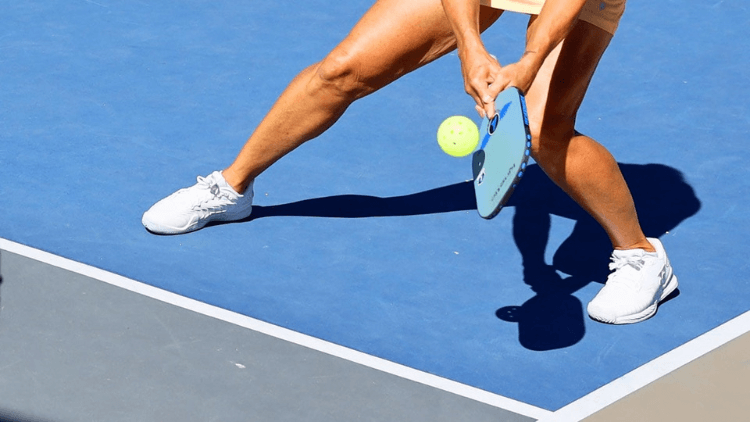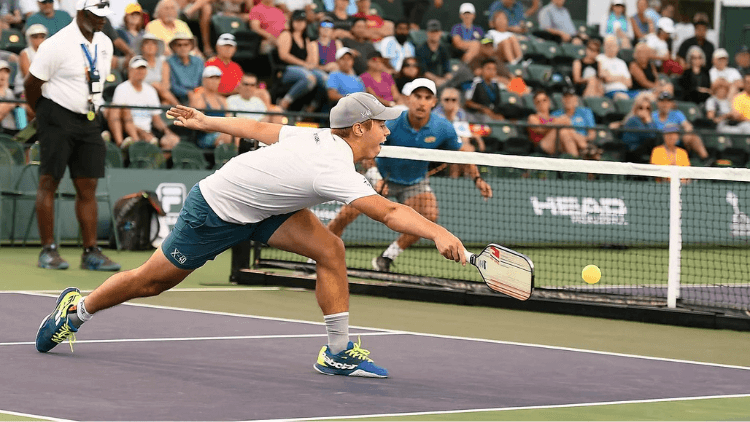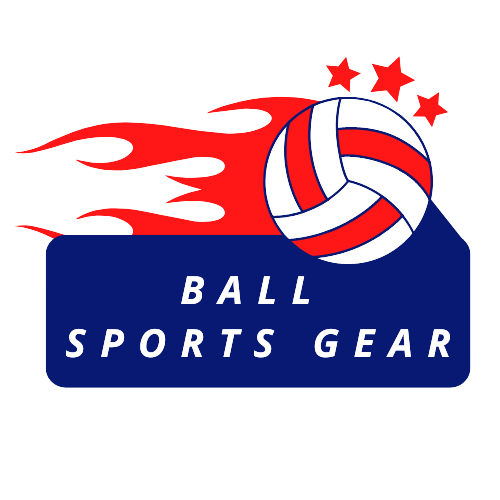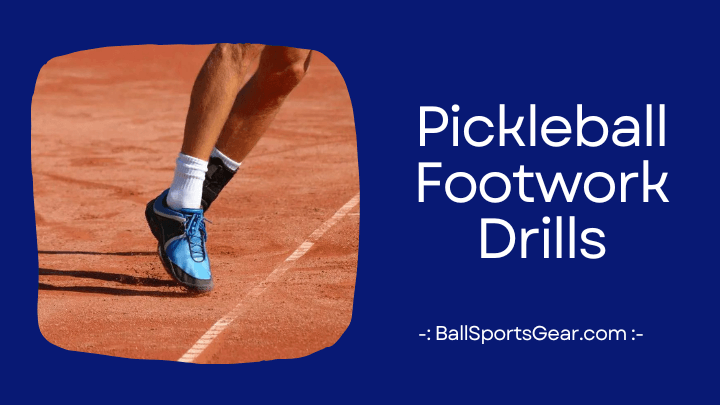Pickleball is a fun and fast-paced sport that combines elements of tennis, badminton, and ping-pong. It can be played by people of all ages and skill levels, and it offers many health and social benefits. However, to play pickleball well, you need more than just a paddle and a ball. You also need good footwork.
Footwork is the foundation of any pickleball game. It allows you to move efficiently and effectively on the court, to position yourself for optimal shots, and to react quickly to your opponent’s moves. Without good footwork, you will be slow, clumsy, and vulnerable to errors and injuries.
Pickleball footwork routines are crucial for enhancing your skill because of this. Exercises that improve your mobility, balance, agility, and reaction time include pickleball footwork drills. They can also increase the enjoyment and difficulty of your game.
You may practice these six pickleball footwork drills alone or with a partner after reading this blog post. These exercises will assist you in developing your lateral movement, recovery, direction change, net approach, and retreat skills. You will see a considerable increase in your pickleball ability and enjoyment by performing these drills frequently.
Side Shuffle Drill
The side shuffle drill is one of the most basic and important pickleball footwork drills. It helps you move laterally along the baseline or the no-volley zone, which is essential for covering the court and hitting effective shots.
To do this drill, you need a partner who will feed you balls from across the net. You start at one corner of the court and shuffle your feet from side to side without crossing them over. Your partner hits balls to different spots on your side of the court, and you try to hit them back with a forehand or a backhand stroke.
Some tips on how to perform this drill correctly and safely are:
- Keep your knees bent and your center of gravity low
- Maintain a balanced stance with your feet shoulder-width apart
- Move your feet quickly but smoothly
- Keep your eyes on the ball and your paddle ready
- Hit the ball in front of your body with a compact swing
- To make this drill more interesting or difficult, you can:
- Vary the speed, spin, and direction of the balls
- Use different types of strokes, such as volleys or dinks
- Shuffle faster or slower
- Increase or decrease the distance between the cones
Return to the Middle Drill
After making a shot, you can regain position by doing the practise “return to the middle.” In order to be prepared for the following shot and stop your adversary from taking advantage of any weaknesses in your defence, you must do this.

You’ll need a teammate to help you with this practise who can feed you balls from the other side of the net. Beginning in the centre of the court, you hit the ball to one corner of the opposing court. After that, you swiftly make your way back to the centre and strike another ball into the other corner. Until you run out of balls or become exhausted, you continue this procedure.
Some tips on how to perform this drill correctly and safely are:
- Use short steps to move back to the middle
- Turn your hips and shoulders as you hit the ball
- Keep your paddle in front of you as you move
- Hit the ball with good depth and placement
- Breathe deeply and rhythmically
- To make this drill more interesting or difficult, you can:
- Vary the speed, spin, and direction of the balls
- Use different types of strokes, such as lobs or drop shots
- Move closer or farther from the net
- Increase or decrease the number of balls
Cross over in Front Drill
When travelling forward or backward, the cross over in front drill helps you cover more territory. When necessary, this is helpful for moving towards or away from the net.
You’ll need a partner for this exercise who can feed you balls from the other side of the net. Starting in the corner of the court, you move forward or backward by crossing one foot over the other in front of you. Your partner hits balls to various locations on your side of the court, and you attempt to return the favour by forehanding or backhanding the ball.
Some tips on how to perform this drill correctly and safely are:
- Keep your knees bent and your center of gravity low
- Maintain a balanced stance with your feet shoulder-width apart
- Move your feet quickly but smoothly
- Keep your eyes on the ball and your paddle ready
- Hit the ball in front of your body with a compact swing
- To make this drill more interesting or difficult, you can:
- Vary the speed, spin, and direction of the balls
- Use different types of strokes, such as volleys or dinks
- Cross over faster or slower
- Increase or decrease the distance between the cones
Cross over Behind Drill
When going sideways, the cross over behind drill enables you to swiftly shift direction. This helps you create angles for your own shots and adjust to your opponent’s shots.
You’ll need a partner for this exercise who can feed you balls from the other side of the net. Starting at one court corner, you advance sideways while crossing one foot over the other behind you. Your partner hits balls to various locations on your side of the court, and you attempt to return the favour by forehanding or backhanding the ball.
Some tips on how to perform this drill correctly and safely are:
- Keep your knees bent and your center of gravity low
- Maintain a balanced stance with your feet shoulder-width apart
- Move your feet quickly but smoothly
- Keep your eyes on the ball and your paddle ready
- Hit the ball in front of your body with a compact swing
- To make this drill more interesting or difficult, you can:
- Vary the speed, spin, and direction of the balls
- Use different types of strokes, such as lobs or drop shots
- Cross over faster or slower
- Increase or decrease the distance between the cones
Diagonal Forward Step Drill
The diagonal forward step drill helps you approach the net with control and balance. This is important for finishing points with volleys or smashes.
To do this pickleball footwork drill, you need a partner who will feed you balls from across the net. You start at the baseline and step diagonally forward with one foot and then bring the other foot next to it. You repeat this pattern until you reach the net. Your partner hits balls to different spots on your side of the court, and you try to hit them back with a forehand or a backhand stroke.
Some tips on how to perform this drill correctly and safely are:
- Keep your knees bent and your center of gravity low
- Maintain a balanced stance with your feet shoulder-width apart
- Move your feet quickly but smoothly
- Keep your eyes on the ball and your paddle ready
- Hit the ball in front of your body with a compact swing
To make this drill more interesting or difficult, you can:
- Vary the speed, spin, and direction of the balls
- Use different types of strokes, such as volleys or dinks
- Step faster or slower
- Increase or decrease the angle of your steps
Diagonal Backward Step Drill
You can quickly and steadily escape from the net by practising diagonal backward steps. This is helpful for blocking lobs or deep shots from your adversary.

You’ll need a partner for this exercise who can feed you balls from the other side of the net. Starting near the net, you take a step back diagonally with one foot before bringing the other foot up close to it. Until you hit the baseline, you keep repeating this sequence. Your partner hits balls to various locations on your side of the court, and you attempt to return the favour by forehanding or backhanding the ball.
Some tips on how to perform this drill correctly and safely are:
- Keep your knees bent and your center of gravity low
- Maintain a balanced stance with your feet shoulder-width apart
- Move your feet quickly but smoothly
- Keep your eyes on the ball and your paddle ready
- Hit the ball in front of your body with a compact swing
To make this drill more interesting or difficult, you can:
- Vary the speed, spin, and direction of the balls
- Use different types of strokes, such as lobs or drop shots
- Step faster or slower
- Increase or decrease the angle of your steps
Frequently Asked Questions
A: Pickleball requires good footwork because it helps you move about the court fast and effectively, set yourself up for the best shots, and respond to your opponent’s actions.
A: Due to the fact that it depends on your objectives, degree of expertise, and availability, there is no clear answer to this issue. However, it is generally advised to do pickleball footwork techniques for 15 to 30 minutes at least once or twice a week.
A: Pickleball footwork drills refers to the specific movement patterns and techniques used by players to position themselves on the court effectively. It involves quick changes in direction, lateral movements, and proper weight transfer to maintain balance and react to the ball efficiently.
Conclusion
Pickleball footwork drills are an essential part of improving your game. They help you move efficiently and effectively on the court, position yourself for optimal shots, and react quickly to your opponent’s moves. They also make your game more fun and challenging. By practicing these six pickleball footwork drills regularly, you will see a noticeable improvement in your pickleball performance and enjoyment. You will also reduce your risk of injuries and increase your fitness level.
We hope you found this blog post helpful and informative. If you did, please share it with your friends and fellow pickleball players. Also, don’t forget to subscribe to our newsletter for more pickleball tips, tricks, and news. Happy drilling!

